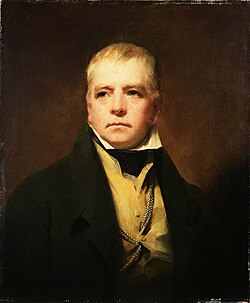
Scottish literature in the nineteenth century includes all written and published works in Scotland or by Scottish writers in the period. It includes literature written in English, Scottish Gaelic and Scots in forms including poetry, novels, drama and the short story.
The most successful literary figure of the era, Walter Scott, began his literary career as a poet and also collected and published Scottish ballads. Scottish poetry is often seen as entering a period of decline in the nineteenth century, with Scots language poetry criticised for its use of parochial dialect and English poetry for its lack of Scottishness. Successful poets included William Thom, Lady Margaret Maclean Clephane Compton Northampton and Thomas Campbell. Among the most influential poets of the later nineteenth were James Thomson and John Davidson. The Highland Clearances and widespread emigration weakened Gaelic language and culture and had a profound impact on the nature of Gaelic poetry. Particularly significant was the work of Uilleam Mac Dhun Lèibhe, Seonaidh Phàdraig Iarsiadair and Màiri Mhòr nan Óran.
There was a tradition of moral and domestic fiction in the early nineteenth century that included the work of Elizabeth Hamilton, Mary Brunton and Christian Johnstone. The outstanding literary figure of the early nineteenth century was Walter Scott, whose Waverley is often called the first historical novel. He had a major worldwide influence. His success led to a publishing boom in Scotland. Major figures that benefited included James Hogg, John Galt, John Gibson Lockhart, John Wilson and Susan Ferrier. In the mid-nineteenth century major literary figures that contributed to the development of the novel included David Macbeth Moir, John Stuart Blackie, William Edmondstoune Aytoun and Margaret Oliphant. In the late nineteenth century, a number of Scottish-born authors achieved international reputations, including Robert Louis Stevenson and Arthur Conan Doyle, whose Sherlock Holmes stories helped found the tradition of detective fiction. In the last two decades of the century the "kailyard school" (cabbage patch) depicted Scotland in a rural and nostalgic fashion, often seen as a "failure of nerve" in dealing with the rapid changes that had swept across Scotland in the industrial revolution. Figures associated with the movement include Ian Maclaren, S. R. Crockett and J. M. Barrie, best known for his creation of Peter Pan, which helped develop the genre of fantasy, as did the work of George MacDonald.
Scottish "national drama" emerged in the early 1800s, as plays with specifically Scottish themes began to dominate the Scottish stage. Scott was keenly interested in drama, writing five plays. Also important was the work of Joanna Baillie. These highly popular plays saw the social range and size of the audience for theatre expand and helped shape theatre-going practices in Scotland for the rest of the century. Despite these successes, provincialism began to set in to Scottish theatre. A number of figures that could have made a major contribution to Scottish drama moved south to London. Many poems and novels were original serialised in periodicals, which included The Edinburgh Review and Blackwood's Magazine. They also played a major role in the development of the short story.
